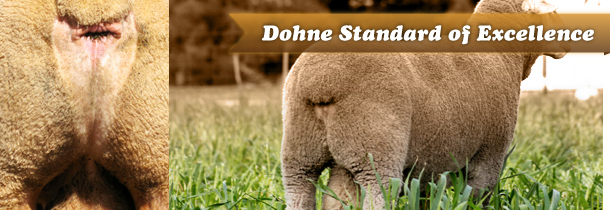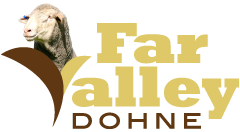Performance Recording
Dohne rams at Far Valley are bred from the highest quality Dohne ewes and the very top grade of Dohne rams. Ram breeding flocks must be registered by the Australian Dohne Breeders Association (ADBA) and breeders must use the Dohne "breed evaluation system".
The Dohne "breed evaluation system" has a primary role to supply commercial producers with highest quality rams that will allow them to efficiently supply their customers with the highest quality products. Commercial producers can purchase rams that are:
- a high quality genetic package
- well described
- easy to accurately select to meet market specifications.
The Dohne "breed evaluation system" is the basis of breed improvement. The system is owned and managed by the ADBA, a body that has strong representation from all sectors of the industry. The Dohne is the only breed of livestock in Australia that requires its ram breeders to maintain and use full pedigree performance records to ensure their product is accurately described
The Dohne "breed evaluation system" uses world best-practice technology and quality assurance. This allows commercial producers throughout Australia to accurately select rams using the same base and description. The system allows buyers to directly compare rams sold by all ADBA ram breeders
Commercial producers who use Dohne rams can breed-up to a Quality Assured purebred flock that is high performing and embodies all the qualities that make the Dohne a unique dual-purpose sheep. A commercial producer breeding-up to a purebred Dohne flock has the opportunity to breed-up within the Dohne Foundation Flock system
The Foundation Flock system allows the quality of each generation to be recognized by the ADBA as meeting breed requirements. In this way a Foundation Flock can progress to become a registered ram breeding flock.
Selecting Rams
Ram selection is easy and is based on a simple system that describes the rams' breeding quality. Straightforward information on all the commercial product traits allows fine-tuning within a suitable grade.
In addition to a ram's general grade, the amount and quality of product a ram's progeny will produce is reported in a standard format. This information allows commercial Dohne breeders to select the rams that will maximize the value of production and accurately target their customers' needs.
The following table (Table 5.1) describes the major measured traits that are assessed and reported to assist ram selection.
TABLE 5.1 The Major measured traits that are assessed and reported.
Scroll sideways to view table.
| Product | Trait name | Abbreviation | Major reason for the assessment |
|---|---|---|---|
| Meat | Body Weight |
wwt pwwt ybwt |
Amount of meat produced. |
| Muscle Size | yemd | Size of the major eating cuts. | |
| Fat Cover | yfat | Amount of fat coverage over the major eating cuts. | |
| Wool | Fleece Weight | ycfw | Amount of wool produced. |
| Fibre Diameter | yfd | Weight and comfort of the cloth. | |
| Variation in fibre diameter | ycvd | Strength of the fibre during processing and comfort of the cloth. |
Each of these traits is measured in units that describe the performance of a ram's (or ewe's) progeny. The units are commonly called Breeding Values and may be abbreviated to 'ASBV' (Australian Standard Breeding Values). A ram's Breeding Value can be very accurately assessed within the Dohne "breed evaluation system" because full account is taken of the performance of each ram and the performance of all its relatives (called pedigree performance) A ram's Breeding Value describes how much different in performance the ram's progeny will be relative to the Dohne Standard of Excellence.
TABLE 5.2 The direction that will improve measured trait performance.
Scroll sideways to view table.
| Product | Trait | The direction that will improve product performance |
|---|---|---|
| Meat | Body Weight | More body weight will maximise the performance of this trait. Therefore animals with a higher Breeding Value for this trait will improve performance as they will produce more saleable meat (if that meat has the same fat cover). |
| Muscle Size | Larger muscle size in the major cuts will maximise performance for this trait. Therefore animals with a higher breeding value for this trait will improve performance as they will produce more saleable meat (if it has the same body weight and fat cover). | |
| Fat Cover | A low fat covering over the major meat cuts will generally maximise performance for this trait. Therefore animals with a lower Breeding Value for this trait will normally Improve performance, as they will produce the optimum coverage of fat. | |
| Wool | Weight | More weight of wool will maximise performance for this trait. Therefore animals with a higher Breeding Value for this trait will improve performance, as they will produce more wool for any period of time. |
| Fibre Diameter | A finer fibre diameter of wool will maximise performance for this trait. Therefore animals with a lower Breeding Value for this trait will improve performance, as they will produce a lower fibre diameter fibre that results in lighter more comfortable clothing. | |
| Variation in Fibre Diameter | A smaller variation fibre diameter of wool will maximise performance for this trait. Therefore animals with a lower Breeding Value for this trait will improve performance, as they will produce a stronger fibre that improves processing performance and less course ends of fibre that results in more comfortable clothing. |
Breeding Value
The Breeding Value of each trait is measured in units commonly used by producers, processors and customers to describe the performance of the product traits. The Breeding Value units are used to describe the level of performance reported relative to the Dohne Standard of Excellence.

TABLE 5.3 The Breeding Value units used to describe the level of performance.
Scroll sideways to view table.
| Meat | Body Weight | Percentage (%) increase or decrease in the body weight of heavyweight lamb. |
| Muscle Size | Millimeters (mm) increase or decrease in the size of meat cuts produced by heavyweight lamb at a constant body weight. | |
| Fat Cover | Millimeters (mm) increase or decrease in the thickness of fat covering the major meat cuts produced by heavyweight lamb. | |
| Wool | Weight | Percentage (%) increase or decrease in adult clean fleece weight. |
| Fibre Diameter | Micron increase or decrease in the wools average fibre thickness in an adult fleece. | |
| Variation in Fibre Diameter | Percentage (%) increase or decrease in the amount of variation in fibre thickness in an adult clean fleece. |
Inspection Assessment
The inspection assessment is aimed to complement the assessment for production and ensures that soundness and trueness to type are maintained. The inspection is carried out by an ADBA approved assessor at 365 days. Inspection Grade is established as AA, A, B, or C. Table 5.4 describes each grade in more detail.
TABLE 5.4 Inspection Grade used to describe soundness and trueness to type.
Scroll sideways to view table.
| Grade | Description | Requirement |
|---|---|---|
|
AA (the highest grade) |
The animal is above average conformation and wool quality. The animal has excellent balance between conformation and wool quality. |
|
| A | The animal may show some deviation in respect of the ideal conformation or wool quality, however, the standard is close to ideal and shows good balance between these properties. |
|
| B | The animal shows a reasonable degree of deviation in respect to the ideal conformation, wool quality and balance. No one of these deviations is, however, sufficiently great to warrant culling on its account. |
|
|
C (the lowest grade) |
If the animal exhibits a culling fault or if the deviations from the ideal conformation or wool quality are very severe, or if there is a severe lack of balance, the animal is culled. | Unfit to be used to breed rams or for commercial production. |

